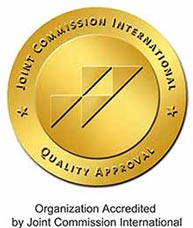
Aortic Valve Repair and Aortic Valve Replacement
Treating diseases that impact the aortic valve often require an aortic valve repair or aortic valve replacement procedure. There are four valves in the heart that are responsible for blood flow and maintaining the flow in the right direction.

The aortic valve is one of these valves and its primary job is to separate the left ventricle, or the main chamber of your heart, and the aorta, the artery sending oxygenated blood throughout your body.
Every time the ventricle contracts, the aortic valve is opened and blood can flow to the aorta. The aortic valve closes again once the ventricle relaxes to stop blood flow in the wrong direction into the ventricle.
If your aortic valve isn’t functioning correctly, blood flow can become hindered, making your heart work much harder to provide enough oxygenated blood to support the circulation of your body.
For some patients, aortic valve disease does not present with any symptoms or warning signs. Other patients, however, are stricken with fatigue, breathing troubles, losing consciousness, chest pain, arrhythmia, cardiac arrest and heart failure.
Why It’s Performed
Aortic valve repair and aortic valve replacement are surgical procedures frequently used for the treatment of aortic valve disease. These procedures regulate blood flow, preserve the heart’s function as a muscle, lessen the frequency and severity of symptoms and can even prolong your life.
Whether or not you receive an aortic valve replacement or repair is based on your symptoms, warning signs, the degree of your aortic valve disease and how fast the condition is worsening.
There are three main kinds of aortic valve disease that can be treated with either aortic valve replacement or repair:
- Congenital heart disease - This condition causes the aortic valve to function improperly and may lead to aortic valve stenosis or regurgitation. For instance, a patient’s aortic valve may not have a sufficient number of cusps, be the wrong size, be the wrong shape or not have a wide enough opening for blood to flow normally, also called atresia.
- Aortic valve stenosis - This condition causes the narrowing or obstruction of the aortic valve, making it more difficult for the aorta to receive blood from the heart pump. Causes of aortic valve stenosis include the thickening of the valves cusps, congenital heart diseases and post-inflammatory issues from rheumatic heart diseases and other conditions.
- Aortic valve regurgitation - This condition causes blood to blow back through the aortic valve into the left ventricle upon relaxing, as opposed to the normal flow of the ventricle to the aorta. A leaky, dysfunctional valve typically causes aortic valve regurgitation, which can be the result of bacterial infection, congenital heart disease or valve deterioration.
Some patients with moderate aortic valve disease do not experience symptoms and may only require careful supervision and monitoring by their doctor. Most patients, however, experience a worsening of symptoms associated with aortic valve disease, in light of medical care.
The majority of aortic valve diseases are mechanical in nature and cannot be effectively treated solely with medication. Patients with advanced conditions will ultimately need surgery to lessen symptoms and the associated risks of aortic valve disease, including cardiac arrest, stroke, heart attack and heart failure.
Choosing Aortic Valve Repair or Replacement
You and your doctor will decide whether aortic valve repair or aortic valve replacement is right for you based on a few key factors
- Your overall physical condition and age
- How severe your aortic valve disease
- Presence of another heart problem that requires surgery, such as treating coronary artery disease with CABG, so both treatments can be performed in one operation.
Generally speaking, a heart valve repair is preferred by physicians because it has a low risk of infection and preserves the function and strength of your valves. In addition, patients typically take less medication for the duration of their lives as compared to other types of valve replacement.
Some valves cannot be repaired, unfortunately, making an aortic valve replacement an easier surgery than moving forward with a heart valve repair procedure. There are many instances, such as a patient with a perforated valve leaflet, in which the aortic repair is better than the aortic replacement.
The right choice for you will depend on your personal condition, as well as the team of cardiologists, physicians and surgeons that are working with you to treat the aortic valve disease.
How It’s Performed
The surgical procedures of aortic valve replacement and aortic valve repair can either be completed through open heart surgery or through a minimally invasive procedure.
Deciding which procedure is right for you comes down to your personal condition, and you and your physician will discuss the advantages of disadvantages of each procedure.
During the conventional method of open heart surgery, the surgeon makes a large incision in the chest. It is common for patients with aortic valve disease to also have coronary artery disease, and this situation may require a bypass surgery to regulate blood flow. Coronary bypass surgery is typically performed through conventional open heart surgery, which allows the aortic valve procedure to be performed concurrently. Some patients with aortic valve disease, for instance, may be contraindicated for open heart surgery because of other health issues that increase the risk of the procedure, including kidney or lung disease.
During the minimally invasive method, the surgeon makes a small incision in the chest or inserts a catheter inserted in the chest or leg, called a transcatheter aortic valve replacement (TAVR). The benefits of minimally invasive aortic valve surgery are a faster recovery time, less time spent in the hospital and less pain when compared to an open heart surgery. In general, minimally invasive heart surgeries are performed by a multidisciplinary medical team with plenty of experiences conducted these procedures.
Leading department specialists

price comparison Israel/US
| Procedure | US Hospitals | Rambam hospital | Average Savings |
| Aortic valve replacement | $80,000 - $200,000 | $35,000 - $39,000 | 38% - 78% |
Cardiac Surgery Packages
| Aortic Valve Replacement | Price $ |
|
The Package Includes: * Up to 7 days of hospitalization. * Cardiology operating room charges: operating room, recovery room, scrub & circulating nurse * Routine laboratory tests necessary for the procedure as ordered by the attending physician. * Radiology Studies: Chest X-ray, if required. * Cardiac investigation: EKG (as required) . * Medications: Routine medication used for procedure, during admission only. * Valve cost. * Equipment costs: Medical Supplies, Routine Cardiology Supplies. * Doctor Fees: Cardiac Surgeon + Anesthesiologist + Assistant Surgeon (if necessary) |
34,700 - 39,000 |








